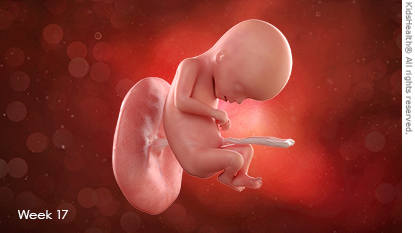- Home
- Humana Medicaid
- Kentucky Medicaid
- Medicaid extras
- Health and wellness
- Parents Home
- Para Padres
- A to Z Dictionary
- Allergy Center
- Asthma
- Cancer
- Diabetes
- Diseases & Conditions
- Doctors & Hospitals
- Emotions & Behavior
- First Aid & Safety
- Flu (Influenza)
- Food Allergies
- General Health
- Growth & Development
- Heart Health & Conditions
- Homework Help Center
- Infections
- Newborn Care
- Nutrition & Fitness
- Play & Learn
- Pregnancy Center
- Preventing Premature Birth
- Q&A
- School & Family Life
- Sports Medicine
- Teens Home
- Para Adolescentes
- Asthma
- Be Your Best Self
- Body & Skin Care
- Cancer
- Diabetes
- Diseases & Conditions
- Drugs & Alcohol
- Flu (Influenza)
- Homework Help
- Infections
- Managing Your Weight
- Medical Care 101
- Mental Health
- Nutrition & Fitness
- Q&A
- Safety & First Aid
- School, Jobs, & Friends
- Sexual Health
- Sports Medicine
- Stress & Coping
Pregnancy Calendar: Week 17
Your Baby's Development
At about 5.1 inches (13 cm) from crown to rump and weighing 4.9 ounces (140 grams), your baby is still very tiny.
The placenta, which nourishes the fetus with nutrients and oxygen and removes wastes, is growing to accommodate your baby. It now contains thousands of blood vessels that bring nutrients and oxygen from your body to your baby's developing body.

Your Body
 You may notice that your breasts have changed considerably since your pregnancy began. Hormones are preparing your breasts for milk production — more blood is flowing to the breasts, and the glands that make milk are growing in preparation for breastfeeding. This can increase your breast size (many women increase 1–2 cup sizes) and make veins become visible. Buy supportive bras in a few different sizes to manage your breast growth during pregnancy.
You may notice that your breasts have changed considerably since your pregnancy began. Hormones are preparing your breasts for milk production — more blood is flowing to the breasts, and the glands that make milk are growing in preparation for breastfeeding. This can increase your breast size (many women increase 1–2 cup sizes) and make veins become visible. Buy supportive bras in a few different sizes to manage your breast growth during pregnancy.

© 1995- The Nemours Foundation. KidsHealth® is a registered trademark of The Nemours Foundation. All rights reserved.
Images sourced by The Nemours Foundation and Getty Images.
